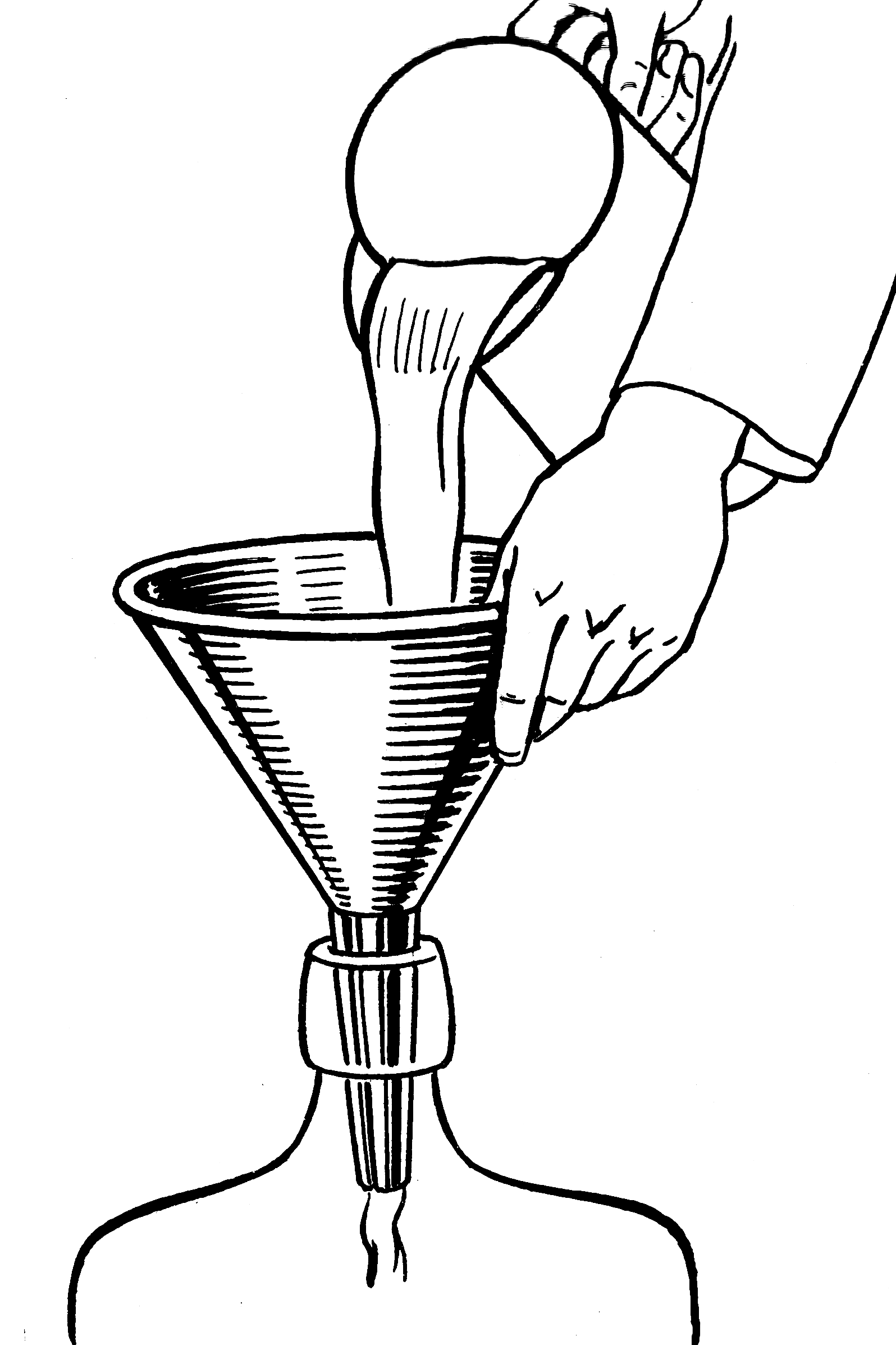The World According To Sound: When Your Wine Bottle Sings
1:59 minutes

A few years ago, Chris Hoff was making himself some plum wine. He had a nice big plum tree in the apartment he was renting in San Francisco, and it had been a plentiful year. During the process he came across a beautiful, simple sound that made him get out his recording gear. It came from his little metal funnel.
Each time Hoff poured liquid through his funnel to fill a bottle, it made this pleasant rising arpeggio of bubbles. When the pitch reached its height, the bottle was filled, and Hoff moved on to the next one. He liked it so much that he grabbed his small handheld recorder and captured the sound.
This simple, everyday sound is the result of a complex interaction of the liquid, bottle, air, and funnel. While water pours down through the funnel, air is being forced out of the bottle and up through the liquid, where it makes a bubble on the surface and then pops. As the level of liquid decreases in the funnel, the pitch of the popping bubbles rises.
At the same time, there is a second process happening with the bottle itself: As the bottle fills with liquid, the volume of air decreases and the pitch of the splashing water rises.
You’ll notice this happening anytime you fill a vessel with liquid. Pay attention the next time you pour yourself some water, tea, or wine. The pitch reaches its peak when the cup is full. Also, for an added bonus, you can tell if the liquid is hot or cold because it makes a different sound. Close your eyes and give it a try.

The pitch rises in Hoff’s bottle of wine—or your cup of water—because they are each acting as a Helmholtz resonator. This is a term to describe the complex physical processes at work to make sound in all of these containers. Any vessel with a small opening can act as a Helmholtz resonator. When you blow on a bottle and it makes a note, or strum a guitar and it resonates out of the body of the instrument, the physics of Helmholtz resonators is at work.
Returning to our wine making sound, the beauty of it goes beyond physics. Sure, the sound is musical in itself, which caught Hoff’s ear. But it’s also one of those sounds that encapsulates an entire physical event. Every rising arpeggio means another bottle is filled.
Even divorced from the physical act of filling the bottle, the sound has its own arc. There is an evocative tension in the sound itself. If you had no idea that some guy in an apartment in San Francisco was filling a bottle with wine, you could still hear a process—a beginning with the low pitch, rising action, and a conclusion.
It’s one of those everyday sounds that connects to the complex physical underpinnings of our world. You can learn a lot from thinking about the sound and trying to understand the physics of its creation. But you can also just close your eyes and listen to the pleasant little bubble, letting it take your mind wherever it wants to go.
The World According to Sound is a live audio show, online listening series, and miniature podcast that focuses on sound, not story. Hoff and co-producer Sam Harnett create intentional, communal listening experiences as a way to “reclaim autonomy in a visually dominated world that is increasingly fracturing our attention.”
This recording is part of their next listening series, an immersive listening party where audiences from all over the globe will be invited to experience a world of sound together, beginning in January 2022. You can get a ticket to the series here.
Invest in quality science journalism by making a donation to Science Friday.
Chris Hoff is the co-producer of The World According To Sound podcast. He’s based in San Francisco, California.
Sam Harnett is the co-producer of The World According To Sound podcast. He’s based in San Francisco, California.
IRA FLATOW: Before we head out this hour, here’s a SciFri soundscape that we think will pair very nicely with our conversation. It’s from Chris Hoff and Sam Harnett of The World According to Sound podcast.
[LIQUID POURING]
[RHYTHMIC SOUND]
[INCREASING PITCH]
SPEAKER: This is wine draining through a funnel. Chris Hoff is making himself some homemade plum wine. When the wine passes through the funnel and into the bottle, air escapes, creating this little bubbly crescendo.
[INCREASING PITCH]
The more liquid that empties from the funnel, the higher the pitch. That’s what happens with a Helmholtz resonator, any vessel with a small opening.
[RHYTHMIC SOUND]
[INCREASING PITCH]
IRA FLATOW: These sounds are part of a communal listening series The World According to Sound is hosting this winter. For more information about their 80-minute binaural events, visit theworldaccordingtosound.org.
Copyright © 2021 Science Friday Initiative. All rights reserved. Science Friday transcripts are produced on a tight deadline by 3Play Media. Fidelity to the original aired/published audio or video file might vary, and text might be updated or amended in the future. For the authoritative record of Science Friday’s programming, please visit the original aired/published recording. For terms of use and more information, visit our policies pages at http://www.sciencefriday.com/about/policies/
John Dankosky works with the radio team to create our weekly show, and is helping to build our State of Science Reporting Network. He’s also been a long-time guest host on Science Friday. He and his wife have three cats, thousands of bees, and a yoga studio in the sleepy Northwest hills of Connecticut.
Kyle Marian Viterbo is a community manager at Science Friday. She loves sharing hilarious stories about human evolution, hidden museum collections, and the many ways Indiana Jones is a terrible archaeologist.
Ira Flatow is the founder and host of Science Friday. His green thumb has revived many an office plant at death’s door.